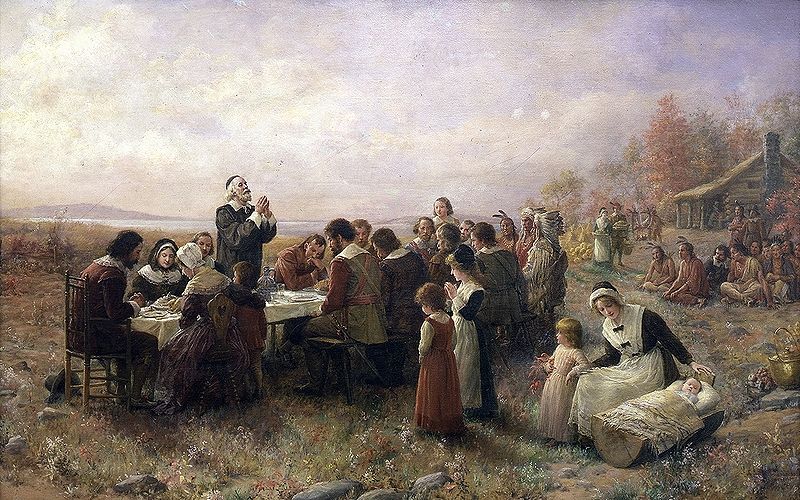
What was the weather for the Pilgrims?
ADVERTISEMENT
Like Randi and Debbie, I think the warm weather coming up is going to dampen the post-Thanksgiving Holiday spirit. I was looking foward to this for a very long time. Even last summer I was dreaming of December. I live in Virginia so some snow would be good (it's terribly dry here) When's the snow coming? Pretty Pretty Please we all want a winter this year!! On December 21 I expect to see winter, not a spring. The frigid air up north is going to have to make it down here eventually. It's intensifying and adding alot of weight. The barrier has to break sometime right? I just hope winter isn't being cancelled..
Food was delicious and my family from Texas came up here to see me. They were complementing our weather here but I wish we could have weather like it was in the 1600s. Winters were guaranteed back in the day. Now that Thanksgiving is over, people are looking foward to the snow but here in Ohio its going to be unusually warm this weekend into next week. Last "winter" if one can call it that, is coming back to haunt us :(
I agree 100%. How could we be tricked into thinking we may actually have a winter this year? 65-70 degrees in December? No, thats just crazy. The thing that really irks me is the fact that I wasted $215 on this heater that I've been dreaming of having!!
ughhh, I guess we can just kiss the white Christmas wishes goodbye here in the middle atlantic right?
I have actually researched extra information about the pilgrims. Im very interested in history. I've learned alot just by the 13 colonies and the Jamestown settlement. The settlers faced many many hardships. Even the pilgrims did when they sailed the Mayflower. America was "The Land of Opportunity" to many Europeans. I love US history, thanks Evelyn for your blog! I loved it!
Thank you. Like you, I love history.
I had a wonderful Thanksgiving. I feel as Thankful as the Pilgrims because there are people in a lot worse shape than all of us. One thing's changed since 1621 and that's the fact that nobody takes time to appreciate the little things in our lives. Of course Black Friday comes around and us Americans fight, push, and go crazy over shopping. People even camp outside the stores just to get in first. I wouldn't think the pilgrims had Black Friday deals though. I love the holidays but I get stressed at times, because it all revolves around the money it seems like but in the end its a true gift. This Christmas, lets just hope we can get that winter! A warm December would make me very upset so I hope the cold weather sticks for good. NOAA's 6-10 and 8-14 day forecasts doesent look to good! I see red, reds not a good color for the midwest & east. I want to see some blue. Will this December be unusually warm once again? thats the look of it. Lets all be thankful for colder weather. A winter is my present in Illinois but you cant get too greedy. Mother nature may have spring in mind this winter. Happy Holidays Evelyn!
Happy Holidays!
I drove two elderly friends with limited budgets to Black Friday and they were thankful for the savings. Despite all the news stories of rude behavior, people were nice to them. It can be stressful, but the holidays do provide some lovely warm moments in the coldest part of the year.
1621 to this day, Thanksgiving is one of the most famous holidays. We're talking almost 400 years ago and the tradition grew. America's adopted this from that one October evening when the pilgrims celebrated and fiested. If you ask me they sounded like great people. Say thank you to the pilgrims! Its the day before Thanksgiving and I'm cooking the delicious ham and turkey. Oh dear, I have alot to cook tomorrow morning. Anyone want a plate? There's no telling what my relatives are bringing, plenty of food I assume haha! Have a Great Thanksgiving Folks!
The weather is looking delightful for Thanksgiving, 60 degrees and sunshine in central Virginia. Couldn't ask for much more in late November, when we're fortunate to be in the 50s. Especially when I hear its going to get DOWNRIGHT COLD come December
It sounds like a delightful day and very much in the spirit of the original celebration.
I join you, "Have a Great Thanksgiving Folks!"
13 years after the settlement in Jamestown, Virginia in 1607 the Pilgrims first landed in Cape Cod, Massachusetts in 1620. Winters have always been quite harsh, even to this day. The fortunate thing was, it was October. Winter hasent settled in with them yet. The weather had to be quite mild and beautiful. Sometimes I wonder, how was the November of 1621? (modern-day Thanksgiving) I live in PA, we're on track to be in the 60s this Thanksgiving! That's good timing because a reality check is underway. I'm not dreading it though, we have Christmas coming around, it needs to cool down! Everyone, have a great Thanksgiving and take time to be thankful for all you have. That turkey, stuffing, mashed potatoes, green beans, fruit salad and the pies that my sister makes sounds GREAT right about now!!










